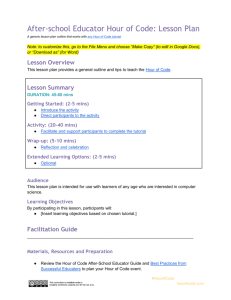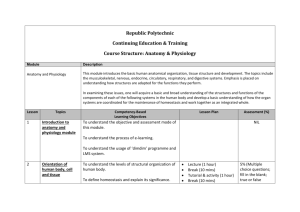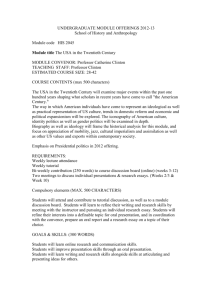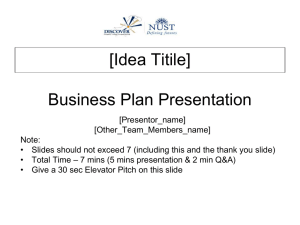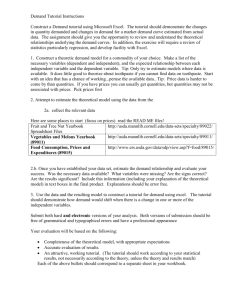template lesson plan
advertisement
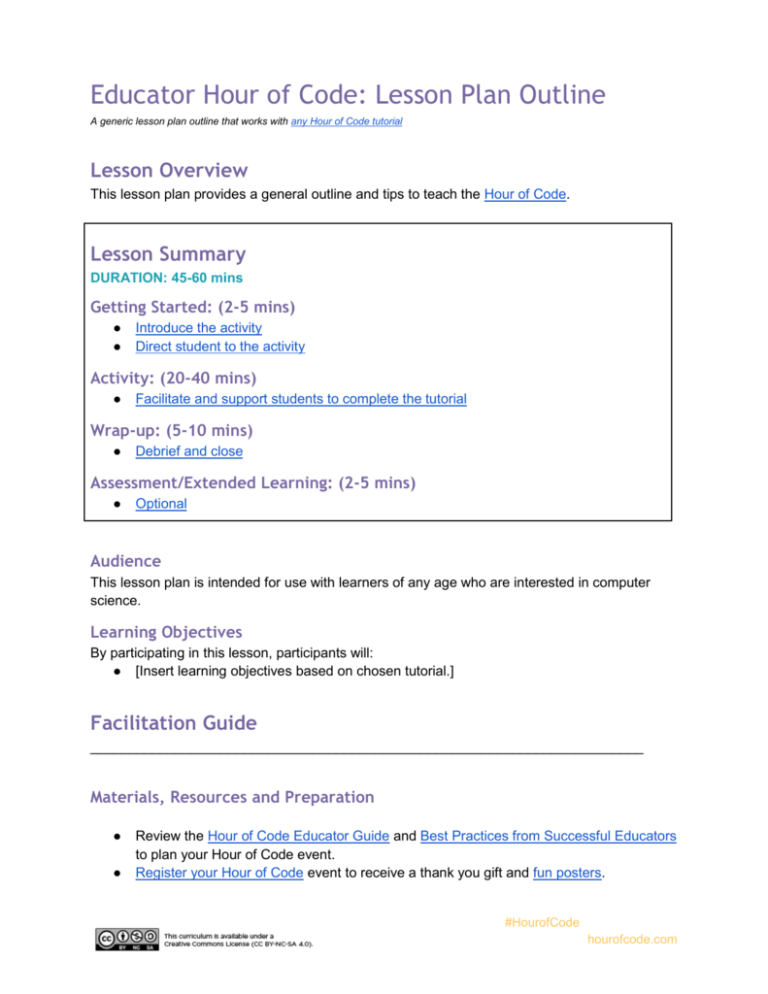
Educator Hour of Code: Lesson Plan Outline A generic lesson plan outline that works with any Hour of Code tutorial Lesson Overview This lesson plan provides a general outline and tips to teach the Hour of Code. Lesson Summary DURATION: 45-60 mins Getting Started: (2-5 mins) ● ● Introduce the activity Direct student to the activity Activity: (20-40 mins) ● Facilitate and support students to complete the tutorial Wrap-up: (5-10 mins) ● Debrief and close Assessment/Extended Learning: (2-5 mins) ● Optional Audience This lesson plan is intended for use with learners of any age who are interested in computer science. Learning Objectives By participating in this lesson, participants will: ● [Insert learning objectives based on chosen tutorial.] Facilitation Guide ________________________________________________________________________ Materials, Resources and Preparation ● ● Review the Hour of Code Educator Guide and Best Practices from Successful Educators to plan your Hour of Code event. Register your Hour of Code event to receive a thank you gift and fun posters. #HourofCode hourofcode.com Educator Hour of Code: Lesson Plan Outline A generic lesson plan outline that works with any Hour of Code tutorial ● ● ● ● Review the unplugged lessons and online tutorials available on code.org/learn, and choose one to run with your students. If you’re running an online tutorial, be sure to test it first before asking your students to complete it. Check your technology and decide if you need to troubleshoot anything in advance. Print certificates to hand out at the end. Student engagement: 15-25 per facilitator, elementary or middle school, no prior skill necessary. Getting Started (2-5 mins) Introduce the activity (2-5 minutes) Kick off your Hour of Code by inspiring students and discussing how computer science impacts every part of our lives. Show one of our inspirational videos to frame the discussion: ○ For K-8 students, we recommend “The Hour of Code is Here.” ○ For older students, we recommend “Anybody Can Learn.” It’s okay if both you and your students are brand new to computer science. Here are some ideas to introduce your Hour of Code activity: ● ● ● ● ● Explain ways technology impacts our lives, with examples both boys and girls will care about (Talk about saving lives, helping people, connecting people, etc.). ○ 3D printing is being used to create limbs for amputees; microchips to find lost pets; Skyping relatives who are far away to keep in touch. Explain that learning computer science is more than learning to code in a computer language, it's about learning how computers and software are changing everything in our world. ○ Digital animation in movies like Inside Out, Shaun the Sheep, Star Wars or Hunger Games; recording music with GarageBand on your computer, mobile banking. Let students know that it's important to learn more about how technology works regardless of what career they want to go into. ○ Farming (using data for watering and fertilizing), fashion (programmable LED dresses at NYFW 2015), medicine (using robots for surgery) As a class, list things that use code in everyday life, or a list of careers the require knowledge of coding or computers. See tips for getting girls interested in computer science here. #HourofCode hourofcode.com Educator Hour of Code: Lesson Plan Outline A generic lesson plan outline that works with any Hour of Code tutorial Direct students to the activity (1 minute) ● ● ● Write the tutorial link(s) you’ve chosen on a whiteboard. Find the link listed on the information for your selected tutorial under the number of participants. Tell students to visit the URL and start the tutorial. Tip: For younger students, load the tutorial page ahead of time or save it as a bookmark. Activity (20-40 mins) Facilitate and support students to complete the tutorial, alone or in groups When your students come across difficulties It’s okay to respond: ● “I don’t know. Let’s figure this out together.” ● “Technology doesn’t always work out the way we want.” ● “Learning to program is like learning a new language; you won’t be fluent right away.” What to do if a student finishes early? ● Students can see all tutorials and try another Hour of Code activity at code.org/learn ● Or, ask students who finish early to help classmates who are having trouble with the activity. Wrap-Up (5-10 mins) Debrief & Close ● ● ● Debrief the activity. Celebrate and pass out certificates and stickers. Share photos and videos of your Hour of Code event on social media. Use #HourOfCode and @codeorg so we can highlight your success, too! Other ideas ● ● ● Do a gallery walk so students can see each other’s work. Do a “Think-Pair-Share” to allow students to reflect individually, discuss with a partner and share out as a group. Let participants know they can continue to learn at http://code.org/learn/beyond. Assessment/Extended Learning (2-5 mins) Optional Time permitting, challenge your students to reflect on the day’s activities and continue their learning. Consider: ● Exit Ticket. Have students complete an Exit Ticket before leaving to assess learning. ● Flip your classroom. Challenge students to pick one of the tutorials they didn’t complete today, but that one of their friends did, and try to do it on their own at home. #HourofCode hourofcode.com Educator Hour of Code: Lesson Plan Outline A generic lesson plan outline that works with any Hour of Code tutorial ● Writing prompt. Have students journal at home about what they learned and how it made them feel. Beyond one hour There are many ways to go Beyond an Hour of Code: ● ● ● Explore other curricula from our partners. Teach the Code Studio Computer Science Fundamentals courses. Code.org offers free professional development for these courses, online or in-person. Invite a computer science expert to your class. Sign up for a virtual classroom. #HourofCode hourofcode.com
